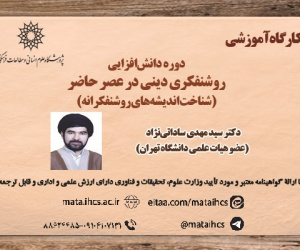بررسی اثرات آگاهی از فرونشست زمین بر گردشگری مسئولانه (نمونه موردی: محدوده شهر نیشابور) (مقاله علمی وزارت علوم)
درجه علمی: نشریه علمی (وزارت علوم)
آرشیو
چکیده
فرونشست سطح زمین، از جمله مخاطرات محیطی است که بشر در دهه های اخیر به دلیل برداشت بی رویه از منابع آب های زیرزمینی در بخش های آبرفتی با آن مواجه شده است. این پدیده همانند سایر مخاطرات (زلزله، خشکسالی، سیل، طوفان و لغزش و ...) از جمله موانع توسعه اقتصادی- اجتماعی و عمرانی به شمار می رود. دشت نیشابور، از جمله مهم ترین دشت های استان خراسان رضوی از نظر کشاورزی و تراکم جمعیتی است که با اقلیمی خشک و نیمه خشک در شمال شرق ایران قرار دارد. این تحقیق به منظور پایش میزان فرونشست رخ داده در محدوده شهر نیشابور صورت گرفته و از تصاویر ماهواره ای «Sentinel 1A» در بازه زمانی 5 ساله (2017 تا 2022) استفاده شده است. هدف اصلی تحقیق حاضر، بررسی اثرات آگاهی از فرونشست زمین بر گردشگری مسؤلانه در محدوده شهر نیشابور می باشد. نتایج مطالعات حاصل از تداخل سنجی راداری نشان داد که در طول بازه زمانی 5 ساله در منطقه مورد مطالعه 18 سانتی متر فرونشست رخ داده است. جهت شناخت علت فرونشست زمین، از داده های چاه های پیزومتری موجود در منطقه استفاده شد و میزان تغییرات آن ها در طول دوره 1398-1370 بررسی گردید. میزان فرونشست های ثبت شده برای هر دوره به ترتیب 4 سانتی متر برای 2017-2018(1395-1396)، برای دوره 2018-2019(1396-1397) حدود 6 سانتی متر، 5 سانتی متر برای دوره 2019-2020(1397-1398) و 2 سانتی متر برای دوره 2020-2021(1398-1399) و 1 سانتی متر برای دوره 2021-2022(1399-1400) به دست آمد. نتایج تحقیق نشان داد که در محدوده شهر نیشابور، ارتباط تنگاتنگی بین افت سطح آب های زیرزمینی و مناطق دارای فرونشست زمین وجود دارد که بر گردشگری مسؤلانه تأثیر گذاشته است. خصوصا در قسمت شمال شهر که بیش ترین میزان افت سطح آب های زیرزمینی 36/78 متر را دارا می باشد و در پهنه خطر فرونشست زیاد هم قرار دارد. با توجه به تحلیل نتایج به دست آمده در نرم افزار «SPSS» و «Smart Pls»، تمامی امتیازات بار عاملی بالاتر از 0.5، آلفای کرونباخ برای هر دو مقدار اصلی بالاتر از 0.7 و ضرایب AVE بالاتر از 0.5 بود. بنابراین روایی گرایی و پایایی تأیید شد. در نهایت تأثیر آگاهی از فرونشست بر گردشگری مسؤلانه تأیید شد. این موضوع بیانگر آن است که آگاهی از فرونشست نیشابور، به عنوان یک چالش زیست محیطی، بر تصمیم گیری های گردشگری گردشگران تأثیرگذار بوده است.Investigation the Effects of Land Subsidence Awareness on Responsible Tourism (Case Study: Neyshabur City Area)
Land subsidence is one of the environmental hazards that humanity has faced in recent decades due to excessive extraction of groundwater resources in alluvial areas. This phenomenon, like other hazards (earthquakes, droughts, floods, storms, landslides, etc.), is considered an obstacle to socio-economic and civil development. The Neyshabur Plain is one of the most important plains in Khorasan Razavi Province in terms of agriculture and population density, which is located in the northeast of Iran with an arid and semi-arid climate. In this study, Sentinel 1A satellite images were used in a 5-year period (2017 to 2022) to monitor the rate of subsidence within the city of Neyshabur. The main objective of the present study is to investigate the effects of land subsidence awareness on responsible tourism within the city of Neyshabur. The results of radar interferometry studies showed that 18 cm of subsidence occurred in the study area during a 5-year period. Data from piezometric wells in the area were used to determine the cause of land subsidence, and their changes were examined during the period 1370-1398. The registered subsidence rates for each period were 4 cm for 2017-2018 (1395-1396), about 6 cm for the period 2018-2019 (1396-1397), 5 cm for the period 2019-2020 (1397-1398), 2 cm for the period 2020-2021 (1398-1399), and 1 cm for the period 2021-2022 (1399-1400). The results of the study showed that there is a close relationship between the decline in groundwater levels and areas with land subsidence in the city of Neyshabur, which has affected responsible tourism. Especially in the northern part of the city, which has the highest groundwater level decline of 36.78 meters and is also in a high subsidence risk zone. According to the analysis of the results obtained in SPSS and Smart Pls software, all factor loading scores were higher than 0.5, Cronbach's alpha for both main values was confirmed and more than 0.7, and the AVE coefficients were also obtained more than 0.5, and validity and reliability were confirmed. Finally, the effect of awareness of subsidence on responsible tourism was confirmed, indicating that awareness of Neyshabur subsidence, as an environmental challenge, has affected tourists' tourism decisions.







